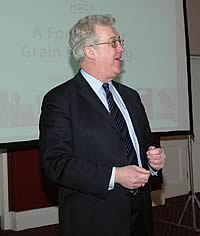The Arable Group’s (TAG) 2005 biannual conference on Wednesday (February 9) at the Scotch Corner Hotel, dedicated to questioning the implications of the Mid Term Review changes for arable farmers, was attended by 170 delegates.
TAG conference 2005
 |
With pending reductions to the Single Farm Payment, arable producers would have to seek more returns from the market in future, Alastair Dickie, crop marketing director of HGCA told the conference.
SFP reductions would come from EU modulation at 4 per cent as well as UK modulation to be determined over and above this which would be a further 5 per cent.
Up to 3 per cent of payments would be held back for the National Reserve to cover hardship cases with a further 10 per cent of payments held back for the National Envelope to address negative issued from decoupling, to improve marketing and to encourage specific farming types.
On tope of this, to be decided in June this year and implemented from 2006 would be an annual adjustment to direct payments if the EU budget is forecast to exceed the ceiling, which could account for up to 11 per cent reduction to the SFP.
Mr Dickie said consumers shopped in supermarkets who in turn buy from manufacturers. Supermarkets provided a quality guarantee and wanted turnover.
So there was a need for reliable suppliers, traceability and quality assurance and supplier relationships.
Exports accounted for 22 per cent of UK wheat use with flour milling (26 per cent) and compound feed use (31 per cent) having the biggest share.
On-farm feeding accounted for 10 per cent of use with distilling across the UK only 4 per cent although for Scottish growers this could be more than 70 per cent of the local market.
With barley, on farm use accounts for 41 per cent of use with malting accounting for 30 per cent across the UK with regional differences in requirements. Seventeen per cent of barley goes for export with 10 per cent going into compound feed.
Mr Dickie said savings could be made on both marketing and haulage costs. He gave an example of where savings could be made in both areas.
A milling wheat supplier close to a flour mill enters into an annual supply contract for January to March delivery with the price fixed at the seller’s request.
This resulted in haulage savings shared and the quality risk avoided with the miller having secure supplies of a known quality.
Branding helped the supplier get a share of the premium by delivering value and security. Examples were in malt whisky where there were long-term supplier contracts. Other examples were Jordans Conservation Grade Products and East Anglian Country Loaf.
“Marketing is a conventional business skill. It is the business process for identifying, anticipating and meeting customer needs,” said Mr Dickie.
Producers needed to identify who was their nearest processor and what they needed. Then producers had to ask how they could change what they did to met the requirements and what could they provide to hold the loyalty.
On the other hand, pricing was a very different skill. Farmers should aim to minimise price risk by setting target prices and working towards them. A pricing plan should also be used and different aspects of the prices separated.

